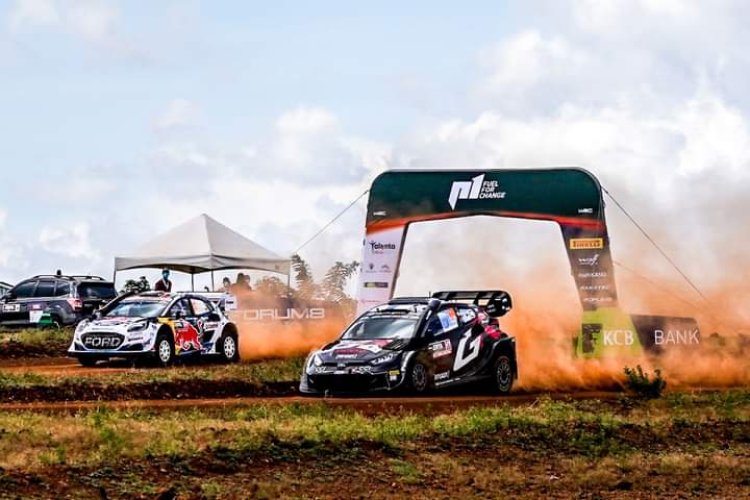In 40 Minutes: How Mechanics Repair WRC Cars Even When Badly Damaged [VIDEO]
To be specific, it took 39 minutes and 30 seconds to complete the repairs, with only 22 seconds left on the clock.
![In 40 Minutes: How Mechanics Repair WRC Cars Even When Badly Damaged [VIDEO]](https://viraltea.co.ke/uploads/images/2024/03/image_750x_6606fd36eb909.jpg)
The World Rally Championship (WRC) Safari Rally is arguably the toughest leg of the WRC circuit taking drivers through some of Africa's most treacherous landscapes in courses expected to challenge competitors' skill and grit with its mix of mud, rocks, sand, and daunting water crossings.
This is something Hyundai's Belgian driver Thierry Neuville knows very well given how the Safari edition has been unkind to him in recent years.
On Friday, March 29, he lost an overnight lead from the opening 4.84km Kasarani Super Special Stage in Nairobi after his rear-right tyre suffered a puncture which damaged most of his rear wing in Kedong, Naivasha, Nakuru County.
The extent of the damage according to photos which went viral on social media reminds one how brutal the Safari Rally continues to be on both local and international drivers, but what was remarkable was how fast it was repaired to make it look like it just came from a car showroom.
Video courtesy of Nation:
A nearly-four-minute video shared by the Nation Media Group (NMG) showed Neuville's Hyundai being attended to by more than 10 mechanics who worked with one eye on the clock to ensure that the car was ready for the Saturday and Sunday stages.
To be specific, it took 39 minutes and 30 seconds to complete the repairs, with only 22 seconds left on the clock.
It turns out that what would take an ordinary mechanic months and thousands of shillings spent on car parts to repair a damage similar to Neuville's takes up to 45 minutes and this is according to the competition's strict regulations on servicing of car.
According to WRC, competitors visit the service park at pre-determined times to allow team technicians to perform mechanical work on their cars. There are usually three service sessions in a day:
- An initial 15-minute visit in the morning before the opening stage
- A 40-minute session midway through a day’s competition
- An end-of-day session lasting 45 minutes in which cars are re-prepared for the following day
Service is tightly governed and time penalties are applied if a competitor exceeds the allotted time in service. At the end of each day’s competition, cars are held in a secure parc fermé (closed park) overnight, securely guarded, with no access for team members or competitors.
Outside of the service park, only a driver and co-driver can work on their car, using only tools and spare parts carried onboard.
During repairs, the mechanics work in synchronization and have to be well-trained to beat the tight deadlines, and as they work, marshals from the Fédération Internationale de l'Automobile (FIA) are present in the service tests and keenly monitor everything.
There are limits on what one can and cannot repair. If a rally car suffers structural damage, there’s no welding it back together and hoping, a driver has to retire.
There are also limits on the number of supplies. For example, even if one wanted to bring a lot of tyres, you are only allowed to use a certain number per rally (which differs for each event, typically something around 20 tyres per car).
Moreover, the cars are cleaned after the event, a process done at every service because a dirty rally car can cover up overlooked damages which can hamper the car's performance during a competition. It's not just about looking appealing to the public eye.
What Are Rally Cars Made Of?
Rally cars are normal cars which are stripped down to the bone. The chassis is fitted with a hollow outer shell that is strengthened and reinforced to take the beating of rally sections and are also much more lightweight than normal cars, thus can go at faster speeds on all kinds of terrain.
What's more, they have roll cages for extra safety so that drivers are not injured in the event of an accident.
This year, Rally 1 cars used in the main WRC class feature both a traditional turbocharged combustion engine with 1600 cubic centimetres and an electric motor providing extra power during accelerations, provided there is energy in the battery. The battery charges when the driver brakes and during service.
In addition to the extra power, electric drive is also used during service park driving and at certain selected parts of transit stages, mainly through communities. A completely fossil-free fuel is used for the combustion engine, standardized for all competitors.
In 2024, three manufacturers participate in the WRC class with Rally1 cars – Ford, Hyundai, and Toyota.


 admin
admin 




